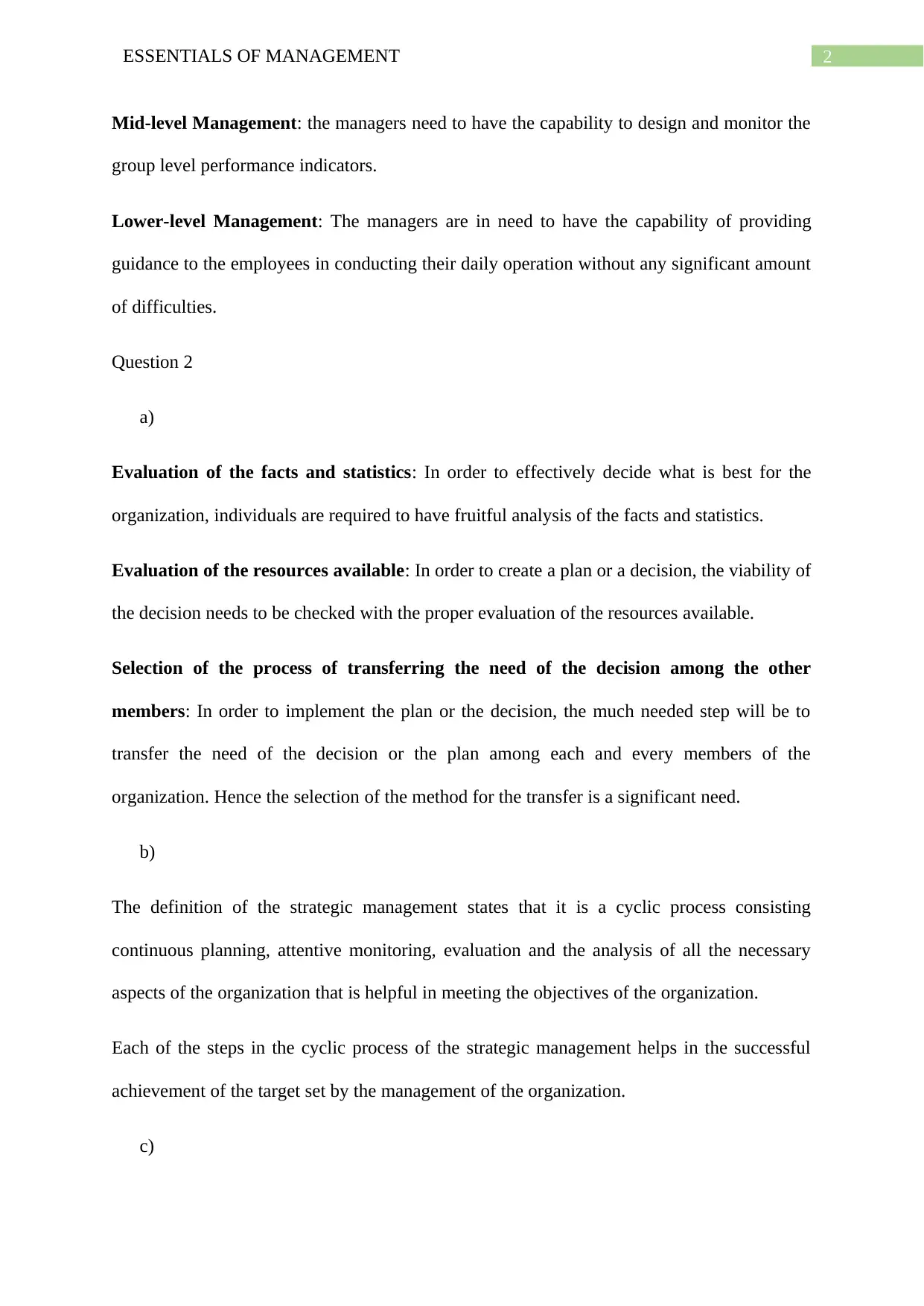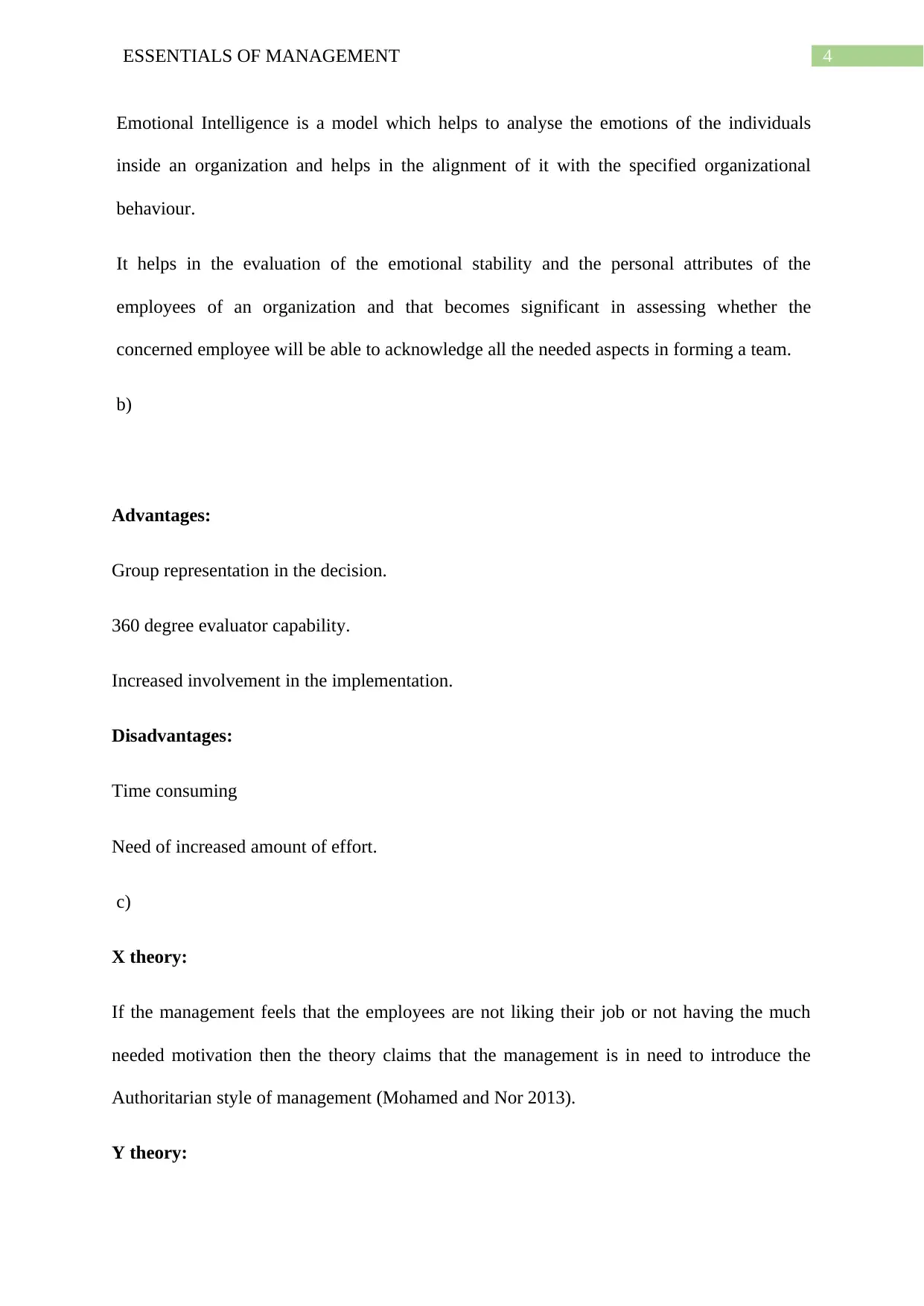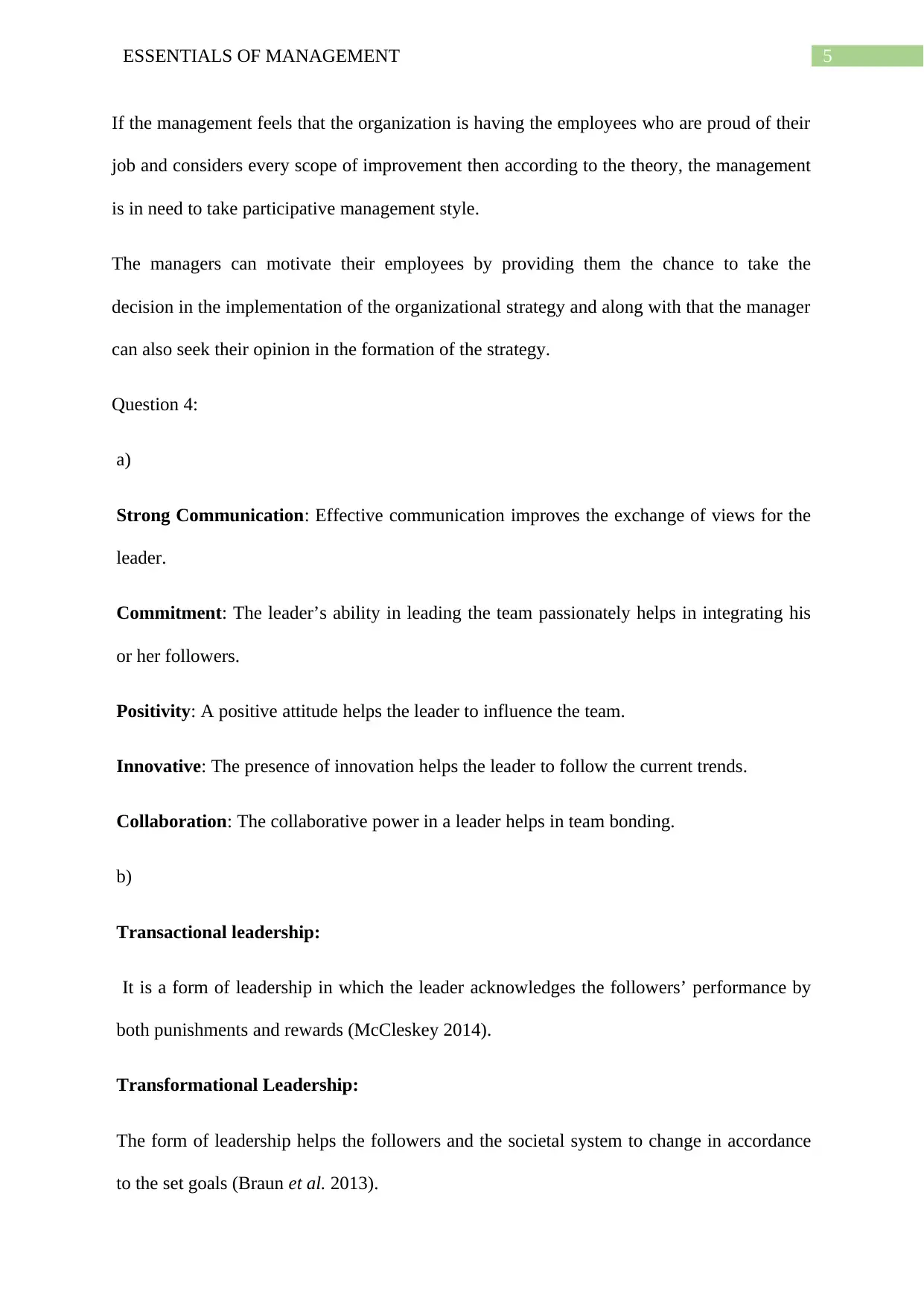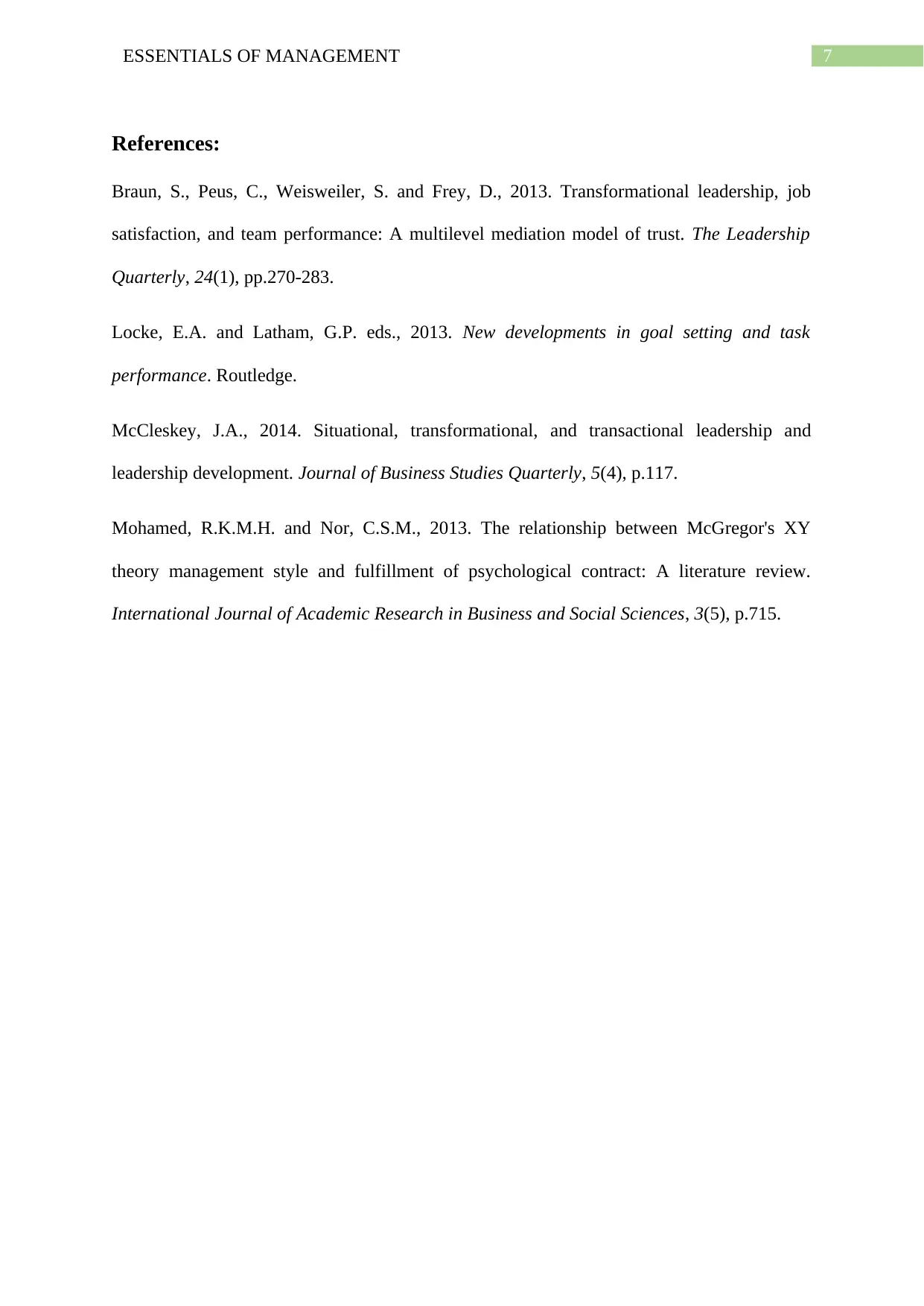Essentials of Management Assignment: Leadership and Decision Making
VerifiedAdded on 2023/05/30
|8
|1344
|65
Homework Assignment
AI Summary
This assignment solution comprehensively addresses key concepts in management, including planning, organizing, and controlling operations. It explores leadership styles, such as transactional and transformational leadership, and examines the importance of emotional intelligence in the workplace. The solution delves into decision-making processes, strategic management principles, and the application of McGregor's X and Y theories. It also covers virtual leadership challenges and the significance of effective communication, commitment, positivity, innovation, and collaboration. The assignment provides insights into goal setting, team dynamics, and the characteristics of effective leaders. The solution also discusses the advantages and disadvantages of various leadership approaches and the role of employee involvement in organizational strategy. The solution also includes references to support the arguments and concepts discussed.

Running head: ESSENTIALS OF MANAGEMENT
Essentials of Management
Name of the Student
Name of the University
Author Note
Essentials of Management
Name of the Student
Name of the University
Author Note
Paraphrase This Document
Need a fresh take? Get an instant paraphrase of this document with our AI Paraphraser

1ESSENTIALS OF MANAGEMENT
Question 1
a)
For the success of the managerial decisions, it is significantly important to effectively plan
the operations that will be conducted. Along with the planning, the managers are liable to
organize the resources that will be used in the process of the implementation of the planned
activity. The other major task for the managers is to control and monitor the activity or the
implementation of the plan so that the progress of the implementation of the plan is in
accordance to the predicted format.
b)
Division of the Work: This section is significantly important as the output or the result of the
task is observed to increase with the competent employees performing in it.
Initiative: The employees of the organizations are observed to perform better with the
achievement of the required freedom to take the initiative.
Authority: The managers are in need to give the orders with all sorts of responsibility for it.
Unity of Command: The employees perform better if there is only one responsible for the
commands.
Unity of Direction: The employees with the same objective must be in the same team and
under the leadership of one manager. This increases the effectiveness of the employees.
c)
Senior level Management: The managers need to have the skills for the development of the
company policies and strategic plans.
Question 1
a)
For the success of the managerial decisions, it is significantly important to effectively plan
the operations that will be conducted. Along with the planning, the managers are liable to
organize the resources that will be used in the process of the implementation of the planned
activity. The other major task for the managers is to control and monitor the activity or the
implementation of the plan so that the progress of the implementation of the plan is in
accordance to the predicted format.
b)
Division of the Work: This section is significantly important as the output or the result of the
task is observed to increase with the competent employees performing in it.
Initiative: The employees of the organizations are observed to perform better with the
achievement of the required freedom to take the initiative.
Authority: The managers are in need to give the orders with all sorts of responsibility for it.
Unity of Command: The employees perform better if there is only one responsible for the
commands.
Unity of Direction: The employees with the same objective must be in the same team and
under the leadership of one manager. This increases the effectiveness of the employees.
c)
Senior level Management: The managers need to have the skills for the development of the
company policies and strategic plans.

2ESSENTIALS OF MANAGEMENT
Mid-level Management: the managers need to have the capability to design and monitor the
group level performance indicators.
Lower-level Management: The managers are in need to have the capability of providing
guidance to the employees in conducting their daily operation without any significant amount
of difficulties.
Question 2
a)
Evaluation of the facts and statistics: In order to effectively decide what is best for the
organization, individuals are required to have fruitful analysis of the facts and statistics.
Evaluation of the resources available: In order to create a plan or a decision, the viability of
the decision needs to be checked with the proper evaluation of the resources available.
Selection of the process of transferring the need of the decision among the other
members: In order to implement the plan or the decision, the much needed step will be to
transfer the need of the decision or the plan among each and every members of the
organization. Hence the selection of the method for the transfer is a significant need.
b)
The definition of the strategic management states that it is a cyclic process consisting
continuous planning, attentive monitoring, evaluation and the analysis of all the necessary
aspects of the organization that is helpful in meeting the objectives of the organization.
Each of the steps in the cyclic process of the strategic management helps in the successful
achievement of the target set by the management of the organization.
c)
Mid-level Management: the managers need to have the capability to design and monitor the
group level performance indicators.
Lower-level Management: The managers are in need to have the capability of providing
guidance to the employees in conducting their daily operation without any significant amount
of difficulties.
Question 2
a)
Evaluation of the facts and statistics: In order to effectively decide what is best for the
organization, individuals are required to have fruitful analysis of the facts and statistics.
Evaluation of the resources available: In order to create a plan or a decision, the viability of
the decision needs to be checked with the proper evaluation of the resources available.
Selection of the process of transferring the need of the decision among the other
members: In order to implement the plan or the decision, the much needed step will be to
transfer the need of the decision or the plan among each and every members of the
organization. Hence the selection of the method for the transfer is a significant need.
b)
The definition of the strategic management states that it is a cyclic process consisting
continuous planning, attentive monitoring, evaluation and the analysis of all the necessary
aspects of the organization that is helpful in meeting the objectives of the organization.
Each of the steps in the cyclic process of the strategic management helps in the successful
achievement of the target set by the management of the organization.
c)
⊘ This is a preview!⊘
Do you want full access?
Subscribe today to unlock all pages.

Trusted by 1+ million students worldwide

3ESSENTIALS OF MANAGEMENT
The well goal designed goals must have the below mentioned characteristics:
The objectives or the goals need to be specific and to the point (Locke and Latham 2013).
The success of the goals need to be measurable.
The goals or the objectives need to relevant.
The objectives or the gaols need to be time bound as well.
d)
The six steps are
Development of the organization’s mission and vision.
Strategic and effective analysis of the organization.
Formulation of the Objectives.
Establishment of the strategy.
Effective implementation of the formed strategies.
Proper monitoring and control of the implementation.
The effective implementation and the formulation of the objectives need the involvement of
the employees as the formation of the objectives will be significantly realistic when it is
formed with the inputs of the employees. Along with that the implementation of the plan
needs to no involvement of the employees as they are the liable section to do it only.
Question 3:
a)
The well goal designed goals must have the below mentioned characteristics:
The objectives or the goals need to be specific and to the point (Locke and Latham 2013).
The success of the goals need to be measurable.
The goals or the objectives need to relevant.
The objectives or the gaols need to be time bound as well.
d)
The six steps are
Development of the organization’s mission and vision.
Strategic and effective analysis of the organization.
Formulation of the Objectives.
Establishment of the strategy.
Effective implementation of the formed strategies.
Proper monitoring and control of the implementation.
The effective implementation and the formulation of the objectives need the involvement of
the employees as the formation of the objectives will be significantly realistic when it is
formed with the inputs of the employees. Along with that the implementation of the plan
needs to no involvement of the employees as they are the liable section to do it only.
Question 3:
a)
Paraphrase This Document
Need a fresh take? Get an instant paraphrase of this document with our AI Paraphraser

4ESSENTIALS OF MANAGEMENT
Emotional Intelligence is a model which helps to analyse the emotions of the individuals
inside an organization and helps in the alignment of it with the specified organizational
behaviour.
It helps in the evaluation of the emotional stability and the personal attributes of the
employees of an organization and that becomes significant in assessing whether the
concerned employee will be able to acknowledge all the needed aspects in forming a team.
b)
Advantages:
Group representation in the decision.
360 degree evaluator capability.
Increased involvement in the implementation.
Disadvantages:
Time consuming
Need of increased amount of effort.
c)
X theory:
If the management feels that the employees are not liking their job or not having the much
needed motivation then the theory claims that the management is in need to introduce the
Authoritarian style of management (Mohamed and Nor 2013).
Y theory:
Emotional Intelligence is a model which helps to analyse the emotions of the individuals
inside an organization and helps in the alignment of it with the specified organizational
behaviour.
It helps in the evaluation of the emotional stability and the personal attributes of the
employees of an organization and that becomes significant in assessing whether the
concerned employee will be able to acknowledge all the needed aspects in forming a team.
b)
Advantages:
Group representation in the decision.
360 degree evaluator capability.
Increased involvement in the implementation.
Disadvantages:
Time consuming
Need of increased amount of effort.
c)
X theory:
If the management feels that the employees are not liking their job or not having the much
needed motivation then the theory claims that the management is in need to introduce the
Authoritarian style of management (Mohamed and Nor 2013).
Y theory:

5ESSENTIALS OF MANAGEMENT
If the management feels that the organization is having the employees who are proud of their
job and considers every scope of improvement then according to the theory, the management
is in need to take participative management style.
The managers can motivate their employees by providing them the chance to take the
decision in the implementation of the organizational strategy and along with that the manager
can also seek their opinion in the formation of the strategy.
Question 4:
a)
Strong Communication: Effective communication improves the exchange of views for the
leader.
Commitment: The leader’s ability in leading the team passionately helps in integrating his
or her followers.
Positivity: A positive attitude helps the leader to influence the team.
Innovative: The presence of innovation helps the leader to follow the current trends.
Collaboration: The collaborative power in a leader helps in team bonding.
b)
Transactional leadership:
It is a form of leadership in which the leader acknowledges the followers’ performance by
both punishments and rewards (McCleskey 2014).
Transformational Leadership:
The form of leadership helps the followers and the societal system to change in accordance
to the set goals (Braun et al. 2013).
If the management feels that the organization is having the employees who are proud of their
job and considers every scope of improvement then according to the theory, the management
is in need to take participative management style.
The managers can motivate their employees by providing them the chance to take the
decision in the implementation of the organizational strategy and along with that the manager
can also seek their opinion in the formation of the strategy.
Question 4:
a)
Strong Communication: Effective communication improves the exchange of views for the
leader.
Commitment: The leader’s ability in leading the team passionately helps in integrating his
or her followers.
Positivity: A positive attitude helps the leader to influence the team.
Innovative: The presence of innovation helps the leader to follow the current trends.
Collaboration: The collaborative power in a leader helps in team bonding.
b)
Transactional leadership:
It is a form of leadership in which the leader acknowledges the followers’ performance by
both punishments and rewards (McCleskey 2014).
Transformational Leadership:
The form of leadership helps the followers and the societal system to change in accordance
to the set goals (Braun et al. 2013).
⊘ This is a preview!⊘
Do you want full access?
Subscribe today to unlock all pages.

Trusted by 1+ million students worldwide

6ESSENTIALS OF MANAGEMENT
In normal productive organizational context the transactional leadership will be the best and
in case of any sort change happening inside any organization, the transformational leadership
will be good.
c)
Challenges of the virtual leadership:
Faulty Communication.
Cultural Differences.
Lack of Training.
d)
Advantages:
It helps in the achievement of the set organizational goals.
Disadvantages:
For many employees, the control over the performances are considered as blocking their
freedom of free conduction of their organizational activity.
In normal productive organizational context the transactional leadership will be the best and
in case of any sort change happening inside any organization, the transformational leadership
will be good.
c)
Challenges of the virtual leadership:
Faulty Communication.
Cultural Differences.
Lack of Training.
d)
Advantages:
It helps in the achievement of the set organizational goals.
Disadvantages:
For many employees, the control over the performances are considered as blocking their
freedom of free conduction of their organizational activity.
Paraphrase This Document
Need a fresh take? Get an instant paraphrase of this document with our AI Paraphraser

7ESSENTIALS OF MANAGEMENT
References:
Braun, S., Peus, C., Weisweiler, S. and Frey, D., 2013. Transformational leadership, job
satisfaction, and team performance: A multilevel mediation model of trust. The Leadership
Quarterly, 24(1), pp.270-283.
Locke, E.A. and Latham, G.P. eds., 2013. New developments in goal setting and task
performance. Routledge.
McCleskey, J.A., 2014. Situational, transformational, and transactional leadership and
leadership development. Journal of Business Studies Quarterly, 5(4), p.117.
Mohamed, R.K.M.H. and Nor, C.S.M., 2013. The relationship between McGregor's XY
theory management style and fulfillment of psychological contract: A literature review.
International Journal of Academic Research in Business and Social Sciences, 3(5), p.715.
References:
Braun, S., Peus, C., Weisweiler, S. and Frey, D., 2013. Transformational leadership, job
satisfaction, and team performance: A multilevel mediation model of trust. The Leadership
Quarterly, 24(1), pp.270-283.
Locke, E.A. and Latham, G.P. eds., 2013. New developments in goal setting and task
performance. Routledge.
McCleskey, J.A., 2014. Situational, transformational, and transactional leadership and
leadership development. Journal of Business Studies Quarterly, 5(4), p.117.
Mohamed, R.K.M.H. and Nor, C.S.M., 2013. The relationship between McGregor's XY
theory management style and fulfillment of psychological contract: A literature review.
International Journal of Academic Research in Business and Social Sciences, 3(5), p.715.
1 out of 8
Related Documents
Your All-in-One AI-Powered Toolkit for Academic Success.
+13062052269
info@desklib.com
Available 24*7 on WhatsApp / Email
![[object Object]](/_next/static/media/star-bottom.7253800d.svg)
Unlock your academic potential
Copyright © 2020–2025 A2Z Services. All Rights Reserved. Developed and managed by ZUCOL.





